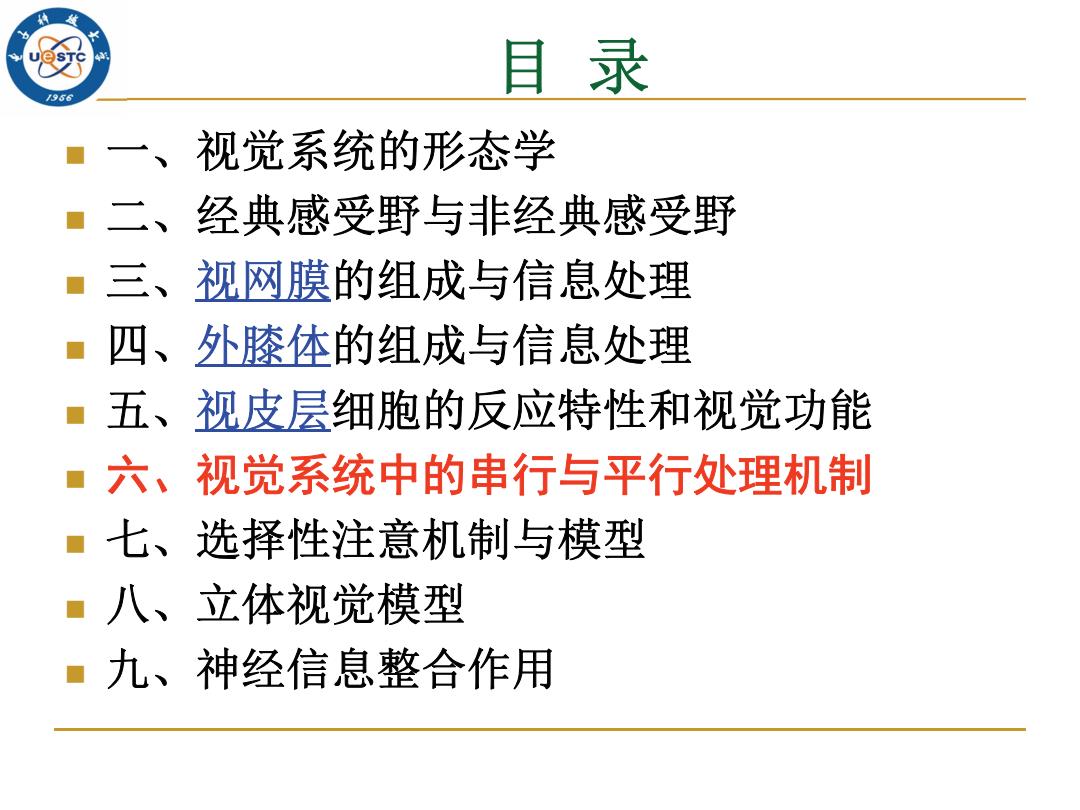
目录 /956 一、 视觉系统的形态学 二、经典感受野与非经典感受野 三、视网膜的组成与信息处理 四、外膝体的组成与信息处理 ■五、视皮层细胞的反应特性和视觉功能 ■六、视觉系统中的串行与平行处理机制 七、选择性注意机制与模型 ■八、立体视觉模型 ■九、神经信息整合作用
目 录 一、视觉系统的形态学 二、经典感受野与非经典感受野 三、视网膜的组成与信息处理 四、外膝体的组成与信息处理 五、视皮层细胞的反应特性和视觉功能 六、视觉系统中的串行与平行处理机制 七、选择性注意机制与模型 八、立体视觉模型 九、神经信息整合作用

/956 Retinal nerve cells Pigmented cell RodPhotoreceptors -Cone Horizontal cell Dorsal pathway Bipolar cell MIP Amacrine cell PMd Optic nerve Ganglion cell VIP P AIP MT Chiasm MS Optic tract LGN MD GN Parwocellular P LGN Koniocellular input Magnocellullar Optic radiation 3 Koniocellular Ventral pathway 4 LGN input 4C. Magnocellullar Parvocellular 6 White matter Solomon Lennie, C.D.Gilbert W.Li, The machinery of colour vision, Top-down influences on visual processing, NATURE REVIEWS NEUROSCIENCE,2007 NATURE REVIEWS NEUROSCIENCE,2013
C.D. Gilbert & W. Li, Top-down influences on visual processing, NATURE REVIEWS NEUROSCIENCE, 2013 Solomon & Lennie, The machinery of colour vision, NATURE REVIEWS NEUROSCIENCE, 2007

HC /956 36 TH 更高级视觉皮层区 域,视觉通路非常 7b FEF 复杂: MSTd LMsT 30多个视皮层区 OT 10多个等级 MOP P 305条视觉联系 PIP 3 V2 P.B P. 猴视觉皮层既平行又分级的30多个 M p.B M 视觉皮层区域间连接的示意图 LGN RGC
猴视觉皮层既平行又分级的30多个 视觉皮层区域间连接的示意图 30多个视皮层区 10多个等级 305条视觉联系 更高级视觉皮层区 域,视觉通路非常 复杂:

FEF It /956 The hierarchy of the LIP levels of visual MT V4 processing in the brain V3 VP V1,the primary visual cortex, is also called the striate cortex. V2 The gray shaded area encloses what is called the extrastriate cortex.The pink shaded area V1 outlines the areas controlling or implementing the motor actions LGN caused by sensory inputs. Retina gaze control "Understanding vision:theory,models,and data",Li Zhaoping
The hierarchy of the levels of visual processing in the brain V1, the primary visual cortex, is also called the striate cortex. The gray shaded area encloses what is called the extrastriate cortex. The pink shaded area outlines the areas controlling or implementing the motor actions caused by sensory inputs. “Understanding vision: theory, models, and data ”, Li Zhaoping

The P,M,and K streams in the primate visual system(Kaplan,2008) Property P M K 1 Clear spectral opponency Yes(red-green) No Some(blue-yellow) 2 Response to light steps Tonic Phasic (transient) Phasic;some sluggish 3 Luminance contrast gain Low High Diverse(some high) 4 Receptive field size Small Large Large 5 Spatial resolution of individual Similar to M Similar to P Diverse(some like M) neurons 6 Retinal ganglion cell density (acuity High Low ? of cell group) 7 Retinal source Midget RGCs Parasol RGCs Unknown(some blue-ON bistratified RGCs) 8 LGN projection target Parvocellular Magnocellular Koniocellular (intercalated) layers 9 V1 projection target Layer 4CB Layer 4Ca Layers 2-3,CO blobs,layer 1 10 Cell body size Small Large Large/varied 11 Conduction velocity of retinal Medium High Low/varied axons 12 Contrast sensitivity at scotopic Poor Good ? luminance 13 Linearity of spatial summation Linear (X-like) 75%Linear,25% Linear (X-like) Nonlinear(Y-like) 14 Extraclassical receptive field Weak Strong Intermediate (varied) effects 15 Number of cells (fraction of LGN ~1000000 70000(6%) 100000(9%) population) (85%)
The P, M, and K streams in the primate visual system (Kaplan, 2008)